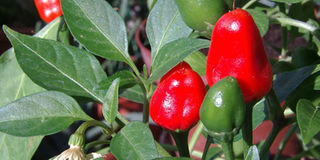Prime
Chilli and onions are essential for your garden

As you plant them, these two vegetables can ensure that you will not be scuttling to the market constantly, to buy over-priced onions and chillies during the dry season Photo by Constance Obonyo
What you need to know:
While it is still raining, why not take advantage of this by planting a few essentials in your garden? Onions and chillies will be essential for your kitchen.
Maybe you’ve been sitting on the sidelines, wondering whether to plant any vegetables or not. Or you slipped a bit and thought it was too late, since you did not do so at the beginning of the rains. Two vegetables that would be good to plant right now are onions and chilli. Don’t intercrop them though, because spacing is important for each. If your plot is small, clearly demarcate the bed.
Onions
According to John Mogoi, an Agronomist with Havana Investments, the types of onions that do well and can be stored for long are the Red Creole and the Red Passion. If well dried, you can keep them in your store for between three to five months. Those are the seeds you need to look out for.
Plant them in nurseries one metre wide. Apply well decomposed animal manure, section the bed into furrows and plant the seeds there. Water the soil until it becomes completely wet. Continue until the seeds start shooting, three to four days later. If it is dry, mulch the nursery bed.
After seven days, most of the seedlings will have germinated. Raise a net shed over them, if you have a net. If not, construct a traditional one using wooden poles for supports and grass to cover the top.
Water the seedlings every afternoon, until you transplant. They will spend 21 days in the nursery bed. Spray them with pesticides. Anything with cypermethrin like Dudu Cyper will do. You can also use foliar, in liquid form, to make them strong.
Transplant the seedlings after 21 days, when they are pencil thick. Make furrows in the seed bed and the spacing should be 10 cm between plants and 30 to 40 cm between rows.
“It takes five to six months for onions to mature. Harvest when the leaves start wilting. Before then, remove some soil from around the plant, so that the bulbs can become bigger. After harvesting, dry them. You can store them for up to five months,” says Mr. Mogoi.
Chilli
Francis Murungi, an agronomist with Miracle Farms at Gerenge in Entebbe says, “You can buy 50 kg of chemicals or fertiliSers and find that it is fake. You can find that it is sand mixed with some colour, which does not dissolve in water. They make it so perfect that it looks like the original product.’
To plant chilli, make a nursery bed between one and one-and-a-half metres wide. The length does not matter, for so long as you can water the plants. Make furrows in the bed, so that the rain does nOt carry the seeds away.
Mix every two tablespoons of chilli seeds with three table spoons of soil, so that the seeds are well spaced. If not, you will get plants congested in only some areas. Plant these in the furrows and cover the bed with grass or a net.
You can alternate between covering and uncovering the bed. For example you can uncover it for two hours in the morning and cover it again if the sun gets too hot. “Nowadays we do what we call “hardening”. We don’t make sheds. We allow them to grow that way, to get used to intense sun; so that when we transplant them, they are already used to a lot of heat,” says Murungi.
The plants will take between 21 and 30 days in the nursery, depending on the fertility of the soil. Make holes in the main bed one-and-a-half feet to three feet between rows and one-and-a-half feet between plants. You will need the space, because chilli plants have fragile branches and if the land is fertile, they tend to be succulent and can break easily.
Water once every two days if it is wet and everyday if it is dry. Chillis will take between one-and-a-half months AND two months to mature. “If the soil is fertile, the results will be excellent, because they over bear. Even the branches break, so you might need to support the branches. You can harvest for between seven to 10 months. It is a perennial plant, so it will not die. You can prune it, but it will keep going for many months. The rate of production will go down slowly with age and the fruit will become smaller,” says Murungi.




